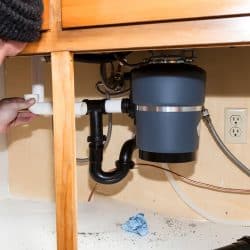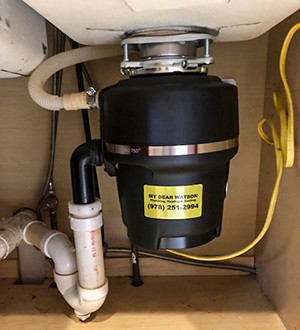Leading Methods for Resolving a Leak in Your Garbage Disposal
Leading Methods for Resolving a Leak in Your Garbage Disposal
Blog Article
Are you looking for insight concerning Tips on Fixing a Leaking Garbage Disposal?

Waste disposal unit are vital kitchen area devices that assist in dealing with food waste successfully. Nonetheless, a dripping garbage disposal can be a discouraging and messy trouble to handle. Fortunately, many leakages can be fixed quickly with a couple of easy actions. In this short article, we will review exactly how to take care of a dripping waste disposal unit successfully.
Intro
Waste disposal unit are set up under kitchen sinks and are made to shred food waste right into smaller sized items, allowing it to go through the pipes system conveniently. While these tools are generally reliable, leakages can occur over time due to damage, loosened connections, or damage to the unit.
Step-by-Step Guide to Fixing a Leaking Waste Disposal Unit
Switch off the Power
Prior to trying any kind of repair services, make certain that the power to the waste disposal unit device is shut off to avoid the danger of electric shock.
Locate the Leakage
Identify the exact area of the leakage and figure out the reason
Tighten up Connections
Utilize a wrench to tighten up any loosened links between the disposal system and the plumbing system.
Replace Seals or Gaskets
If the leakage is due to worn seals or gaskets, remove the old elements and change them with new ones.
Patching Fractures or Openings
For splits or holes in the disposal system, use epoxy or an ideal patching material to seal the broken area.
Identifying the Resource of the Leak
Before attempting to take care of a dripping waste disposal unit, it is essential to identify the source of the leak. This can generally be done through aesthetic assessment or by carrying out straightforward examinations.
Visual Evaluation
Check the waste disposal unit system very carefully for any type of indicators of water leak. Pay close attention to areas around seals, gaskets, and link points.
Checking for Leaks
One means to examine for leaks is by running water via the disposal device and checking for any visible signs of leakage.
Usual Causes of Leakages in Trash Disposals
Worn Seals and Gaskets
Seals and gaskets play an important duty in protecting against water from leaking out of the garbage disposal. In time, these elements can weaken, resulting in leaks around the disposal unit.
Loose Connections
The connections between the garbage disposal and the pipes system can come to be loosened with time, causing water to leak out throughout operation.
Fractures or Holes in the Disposal Unit
Physical damages to the waste disposal unit, such as fractures or holes in the housing, can likewise cause leaks.
Tools and Products Needed for Repairing a Dripping Waste Disposal Unit
Prior to starting the fixing process, gather the essential devices and products, including a screwdriver, flexible wrench, plumbing technician's putty, replacement seals or gaskets, and epoxy or patching material for repairing cracks or holes.
Checking the Waste Disposal Unit After Fixing
As soon as the repair is complete, evaluate the garbage disposal by running water with it to make sure that the leak has been solved.
Preventive Upkeep Tips to Stay Clear Of Future Leakages
To stop future leaks, it is important to do routine upkeep on your waste disposal unit. This includes maintaining it clean, preventing putting non-food products or hard items down the disposal, and regularly looking for leakages or various other concerns.
Final thought
Finally, dealing with a dripping waste disposal unit is a fairly simple procedure that can be completed with fundamental devices and materials. By adhering to the steps described in this short article and exercising preventative maintenance, you can maintain your waste disposal unit in good working problem and avoid expensive fixings in the future.
What to Do About a Leaking Garbage Disposal
A leaking garbage disposal often goes unnoticed until you confront a sopping cabinet, a foul-smelling puddle, or an audible drip-drip-drip from the unit. The fix can be frustrating, too, because the leak can stem from a number of components in the system. Fortunately, with a little sleuthing, you can zero in on the leak and—depending on the exact location—stop the icky oozing and repair the component that caused it. Worst case scenario, if it turns out that the garbage disposal must be replaced, installing a new one is a reasonable do-it-yourself task for those with basic plumbing skills. Read on to keep the cash you’d otherwise hand over to a pro.
Prepare to find the leak
Prior to testing the garbage disposal for leaks, unplug it at the wall outlet and turn off the power from the breaker box to prevent electrical shock. Then insert a watertight sink stopper into your sink drain and wipe the unit dry with a clean cloth. In any handy container, mix a few drops of food coloring into a few cups of water, and pour the dyed water onto the sink stopper to help you locate the leak.
Investigate the source
the top, where the disposal meets the sink drain the side, where the dishwasher hose or main drain pipe connects to the disposal or the bottom of the unit Inspect each of these locations while gliding a light-colored rag over the unit; the dyed water will readily show on the rag and reveal the location of the leak. If a leak isn’t immediately apparent, remove the sink stopper and pour a few more cups of dyed water down the sink drain, then check for leaks again. Leaks near the top of the unit are more likely to show themselves while the sink is plugged, while side and bottom leaks are more noticeable while the sink is unplugged.
The metal sink flange that sits directly inside the sink drain is typically sealed around the top with plumber’s putty (a clay-like sealant) and then secured from under the sink with bolts. If the plumber’s putty deteriorates, or the bolts loosen, the flange can no longer form a watertight seal between the sink drain and the disposal—which could cause a leak at the top of the unit.
To reseal the leaky flange, you must first detach the garbage disposal. Start by loosening the screws securing the main drain pipe to the disposal, then loosen the screws in the metal clamp securing the dishwasher hose to the disposal and detach the drain pipe and dishwasher hose from the disposal. Loosen the screws in the mounting ring that connects the disposal to the metal mounting assembly beneath the sink, then pull down the disposal and carefully set it on a clean, dry surface. Loosen the bolts in the mounting assembly with a wrench, then pull down the mounting assembly and set it near the disposal.

Do you enjoy reading up on The Handy Guide To Fixing Your Garbage Disposal Leaking? Post a remark directly below. We will be pleased to listen to your opinion about this entry. We hope to see you back again in the future. Do you know about anybody else who is serious about the subject? Please feel free to promote it. Kudos for your time. Visit again soon.
Click Here Report this page